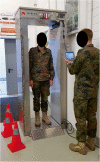Preparing for a "dirty bomb" attack: the optimum mix of medical countermeasure resources
- PMID: 33455578
- PMCID: PMC7812656
- DOI: 10.1186/s40779-020-00291-3
Preparing for a "dirty bomb" attack: the optimum mix of medical countermeasure resources
Abstract
Background: In radiological emergencies with radionuclide incorporation, decorporation treatment is particularly effective if started early. Treating all people potentially contaminated ("urgent treatment") may require large antidote stockpiles. An efficacious way to reduce antidote requirements is by using radioactivity screening equipment. We analyzed the suitability of such equipment for triage purposes and determined the most efficient mix of screening units and antidote daily doses.
Methods: The committed effective doses corresponding to activities within the detection limits of monitoring portals and mobile whole-body counters were used to assess their usefulness as triage tools. To determine the optimal resource mix, we departed from a large-scale scenario (60,000 victims) and based on purchase prices of antidotes and screening equipment in Germany, we calculated efficiencies of different combinations of medical countermeasure resources by data envelopment analysis. Cost-effectiveness was expressed as the costs per life year saved and compared to risk reduction opportunities in other sectors of society as well as the values of a statistical life.
Results: Monitoring portals are adequate instruments for a sensitive triage after cesium-137 exposure with a high screening throughput. For the detection of americium-241 whole-body counters with a lower daily screening capacity per unit are needed. Assuming that 1% of the potentially contaminated patients actually need decorporation treatment, an efficient resource mix includes 6 monitoring portals and 25 mobile whole-body counters. The optimum mix depends on price discounts and in particular the fraction of victims actually needing treatment. The cost-effectiveness of preparedness for a "dirty bomb" attack is less than for common health care, but costs for a life year saved are less than for many risk-reduction interventions in the environmental sector.
Conclusion: To achieve economic efficiency a high daily screening capacity is of major importance to substantially decrease the required amount of antidote doses. Among the determinants of the number of equipment units needed, the fraction of the potentially contaminated victims that actually needs treatment is the most difficult to assess. Judging cost-effectiveness of the preparedness for "dirty bomb" attacks is an issue of principle that must be dealt with by political leaders.
Keywords: Data envelopment analysis; Decorporation treatment; Dirty bomb; Efficiency; Medical countermeasures; Radiological emergency; Radionuclide incorporation; Screening.
Conflict of interest statement
The authors declare that they have no competing interests.
Figures






Similar articles
-
Estimation of radiation-induced health hazards from a "dirty bomb" attack with radiocesium under different assault and rescue conditions.Mil Med Res. 2021 Dec 9;8(1):65. doi: 10.1186/s40779-021-00349-w. Mil Med Res. 2021. PMID: 34879871 Free PMC article.
-
Analysis of the antidote requirements and outcomes of different radionuclide decorporation strategies for a scenario of a "dirty bomb" attack.Am J Disaster Med. 2017 Fall;12(4):227-241. doi: 10.5055/ajdm.2017.0276. Am J Disaster Med. 2017. PMID: 29468625
-
Medical management of victims contaminated with radionuclides after a "dirty bomb" attack.Mil Med Res. 2018 Aug 6;5(1):27. doi: 10.1186/s40779-018-0174-5. Mil Med Res. 2018. PMID: 30086798 Free PMC article.
-
Dirty bomb source term characterization and downwind dispersion: Review of experimental evidence.J Environ Radioact. 2023 Jul;263:107166. doi: 10.1016/j.jenvrad.2023.107166. Epub 2023 Apr 12. J Environ Radioact. 2023. PMID: 37059048 Review.
-
Rays as weapons.Eur J Radiol. 2007 Aug;63(2):167-77. doi: 10.1016/j.ejrad.2007.04.028. Epub 2007 Jul 13. Eur J Radiol. 2007. PMID: 17630244 Review.
Cited by
-
Minutes to hours after a nuclear event: available radiation poisoning antidotes and practical considerations on possible urgent approaches.Eur J Nucl Med Mol Imaging. 2023 Oct;50(12):3498-3505. doi: 10.1007/s00259-023-06305-1. Eur J Nucl Med Mol Imaging. 2023. PMID: 37367964 Free PMC article. No abstract available.
-
Enhancing radioprotection: A chitosan-based chelating polymer is a versatile radioprotective agent for prophylactic and therapeutic interventions against radionuclide contamination.PLoS One. 2024 Apr 3;19(4):e0292414. doi: 10.1371/journal.pone.0292414. eCollection 2024. PLoS One. 2024. PMID: 38568898 Free PMC article.
-
Identifying the components of prehospital emergency preparedness in radiological and nuclear incidents: a scoping review.BMC Emerg Med. 2025 Jul 1;25(1):100. doi: 10.1186/s12873-025-01258-0. BMC Emerg Med. 2025. PMID: 40596856 Free PMC article.
-
Nuclear and Radiological Emergencies: Biological Effects, Countermeasures and Biodosimetry.Antioxidants (Basel). 2022 May 31;11(6):1098. doi: 10.3390/antiox11061098. Antioxidants (Basel). 2022. PMID: 35739995 Free PMC article. Review.
-
Estimation of radiation-induced health hazards from a "dirty bomb" attack with radiocesium under different assault and rescue conditions.Mil Med Res. 2021 Dec 9;8(1):65. doi: 10.1186/s40779-021-00349-w. Mil Med Res. 2021. PMID: 34879871 Free PMC article.
References
-
- Edsall K. Radiological and nuclear incidents and terrorism. In: Walter FG, editor. Advanced hazmat life support (AHLS) provider manual. Tucson: University of Arizona Emergency Medicine Research Center & American Academy of Clinical Toxicology; 2003.
-
- NCRP . Population monitoring and radionuclide decorporation following a radiological or nuclear accident. National Council on Radiation Protection and Measurements: Bethesda; 2010.
-
- Stricklin D, Millage K, Rodriguez J, McClellan G. Americium-241 decorporation model. Technical report DTRA-TR-15-02. Fort Belvoir: Defense Threat Reduction Agency; 2014.
-
- International Atomic Energy Agency (IAEA) The radiological accident in Goiânia. Vienna: International Atomic Energy Agency; 1988.
-
- Krock L, Deusser R. Dirty bomb homepage. Chronology of events. Nova Science Programming on Air and Online. 2003.
MeSH terms
Substances
LinkOut - more resources
Full Text Sources
Other Literature Sources

